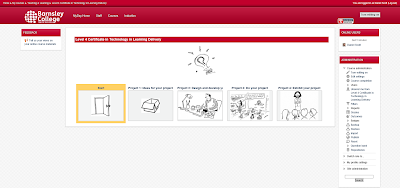I thought I would share an old course and it's online structure that I designed on Moodle. During April 2013 to August 2014 I designed, planned, delivered, assessed and managed the Level 4 Certificate in Technology in Learning Delivery (which I named L4TLD) qualification.
I last mentioned this in a summary of that year.
26 March 2013, me planning the first iteration.
Me - "
My new way of planning! Keep your docs out on display and whenever you get an idea, just write or annotate on them. Better than sat in front of a computer forcing ideas out!"
The course enabled learners which were mostly teachers to choose their own digital technologies and practice and develop their skills in using them. As a result learners improved their understanding and practical application of Technology Enhanced Learning.
Below are the course aims and objectives I created:
Course aims:
- To successfully use, facilitate and manage technology for learning delivery tasks and/or activities.
- Daniel Scott’s personal aim of the course: “Learner led, self-exploration and discovery of own project(s), making excellent creators of innovation in learning and teaching and in your subject areas.”
Course outcomes:
- Develop your IT skills into Information Learning Technology skills
- Use, plan, prepare and manage technology for learning
- Apply and demonstrate technology in learning delivery skills
- Establish how to enhance learning through the use of technology
- Share your learning, knowledge and skills of technology in learning delivery
The course was offered as a part-time 20 week blended delivery and learners attend workshops and participate in online activities. The course ran for two cohorts and the second one was redesigned as Project Based Learning, which is illustrated below of how I structured the online learning aspects.
This was the home page of the course. I used the 'grid view' feature to make it more visually appealing rather than a long linear list of resources. When you click on a tile it opens up a box with the content in. Activity Completion was enabled so that I could see who had interacted and done tasks.

The Start section contains all generic getting started material for the course. My course handbook was very detailed and replicated my Scheme of Work for accuracy and consistency of timescales. Each stage of the project had a brief that outlined the aims and detailed tasks of what needed to be done. In both the course handbook and project briefs I hyperlinked various sections to Moodle. One of which was the example ePortfolio (Google Sites) in which learners had to create for their summative assessment for the course. Other links included the online social network Yammer where some discussions were held and where I communicated resources to Moodle. I also send out an Initial Assessment via Google Forms before the course starts. I ask learners specific questions about their knowledge and skills that relate to the qualification.

Project 1: Ideas for your project got learners to think of ways to use digital technologies and decide which ones they would like to implement into their practices. As part of the blended delivery I created online activities called
Etivities which I explain more about in this post. Workshop presentations were uploaded for anyone wanting to review the content again or for absentees. I structured resources in each section with meaningful titles and used the description fields that provide learners with better direction of what they are and what they need to do with them. Resources were titled against the project briefs for consistency.
Project 2: Design and develop your project got learners to learn practical and online safety aspects and to start planning, preparing and managing their digital technologies to deliver and facilitate learning. As part of this project I introduced Instructional Design for learners to create their own eLearning package.
Project 3: Do your project required learners to carry out their projects with their own learners across different situations so they can get a broader experience with different groups of learners and activities.
Project 4: Exhibit your project required learners to share their learning technology projects within their departments in the style of Continuous Professional Development and the impact it had on them and their learners.








